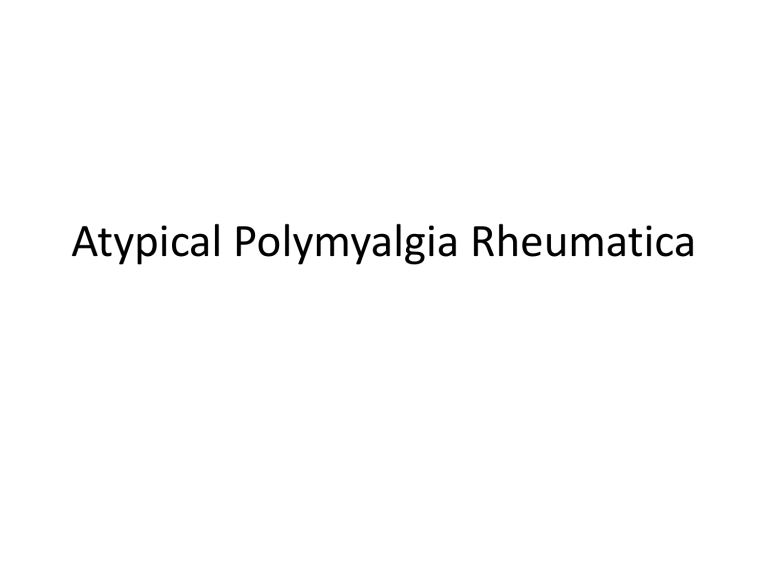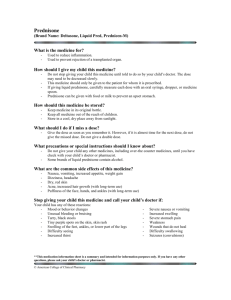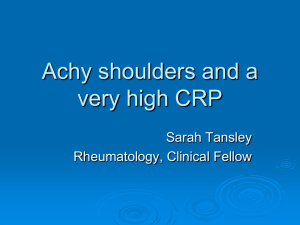Atypical Polymyalgia Rheumatica

Atypical Polymyalgia Rheumatica
A Case Report
• NG is a 47 year old female who developed severe shoulder and upper arm pain bilaterally as well as hip pain , wrist pain and severe morning stiffness in March 2011. She denied ever experiencing anything like this before.
She did admit to losing 30 pounds intentionally after completing the HCG diet one month prior.
• She denied fever, night sweats, rash, mucosal ulcers, strenuous activity, visual changes, jaw claudication, small joint pain, swelling and respiratory symptoms.
Review of Systems
• General : see above
• HEENT: no new headache
• Endocrine: no cold intolerance, polydipsia or polyuria
• Hematologic: no bruising or bleeding
• Skin: no rash
• Respiratory : no cough or dyspnea
ROS Continued
• Cardiovascular: No chest pain, palpitations, or claudication
• Gastrointestinal: No nausea, vomiting, diarrhea , constipation, or change in stools
• Genitourinary: No change in menses, dysuria, frequency, hematuria, or foamy urine
• Musculoskeletal: no active synovitis , but severe pain with ROM of shoulders
ROM Continued
• Neurologic: No motor weakness, numbness, paresthesias, cognitive symptoms
• Psychiatric: recent discontinuation of Zoloft which she had used since 2004
• None
Allergies
Medications
• HCTZ 25 mg po daily
• Metoprolol 12.5 po BID
• KCL 10 meq po daily
• Recent HCG injections completed one month ago
• Ibuprofen 200mg po QID
Past Medical History
• Hypertension
• Depression
• Migraine
• Obesity
Past Surgical History
• Knee surgery bilaterally
• Cholecystectomy
• Foot surgery
• Breast cyst aspiration
Social History
• No smoking
• Rare social alcohol
• No illicit drug abuse
• Lesbian
• Works as a manager at Petsmart
Family History
• Unknown ( Adopted )
Physical Examination
• Vital signs: BP 131/89, Temp 97.6, Weight
201.8, Height 5 feet 2 inches
• Head : normal, No temporal artery tenderness
• Eyes: normal
• ENT: normal
• Lymphatic : no nodes
• Skin: normal
PE Continued
• Chest: Clear to A & P
• Cardiovascular : Normal ( no murmurs or rubs and pedal pulses normal)
• Abdomen : obese ,non tender , no mass, or organomegaly
• Back: No significant findings
• Neurologic : normal
PE Continued
• Musculoskeletal : Severe pain with ROM of the shoulders and hips bilaterally. Some tenderness of the wrists but no active synovitis, and no synovitis of the hands, or feet, or knees
Laboratory
• CMP : normal except AST 64
• Magnesium : normal 2.2
• Phosphate : normal 3.6
• CBC : normal WBC 10.4, Hgb 14, PLT 131
• WSR : 28
• CPK : 53
• TSH : 2.66
Lab Continued
• Vitamin D : 31
• CCP : <1
• RF: <5
• ANA reflex : negative
• CRP : 18.1
Clinical Course
• The patient was empirically treated with
Prednisone 20 mg po daily . She had a
“miraculous” response after the first dose. On her follow up visit she was asymptomatic and her CRP fell to 2.2 . Her prednisone has been slowly tapered subsequently and she continues to do well.
Differential Diagnosis
• Polymyalgia rheumatica
• Seronegative rheumatoid arthritis
• Bursitis / tendonitis
• RS3PE syndrome ( Remitting seronegative symmetrical synovitis with pitting edema )
• Spondyloartropathy
Differential Diagnosis Continued
• CPPD disease ( calcium pyrophosphate deposition disease )
• Fibromyalgia
• Hypothyroidism
• Paraneoplastic syndrome
• Infective endocarditis
• Inflammatory Myopathy
Differential Diagnosis Continued
• Vasculitis
• Miscellaneous ( Parkinson’s disease
Hyperparathyroidism, Drug induced-HCG,
Depression)
Seronegative Rheumatoid Arthritis
• Symmetric polyarthritis of small joints of hands and feet
• Does not respond to low dose steroids
• Can mimic Polymyalgia rheumatica
• Lower WSR and CRP than PMR
Bursitis
• Not bilateral
• Usually does not have elevated WSR or CRP
RS3PE Syndrome
• Remitting seronegative symmetrical synovitis with pitting edema
• Sudden onset of polyarthitis
• Negative rheumatoid factor
• Distal joint involvent
• Some response to steroids
• May be paraneoplastic
Spondyloarthropathy
• Proximal symptoms
• Elevated WSR
• Axial skeletal involvement
• Edema
• Constitutional symptoms
• Enthesitis
Spondyloarthropathy Continued
• Uveitis
• Sacroillitis
• HLA –B27
CPPD Disease
• Calcium pyrophoshate deposition disease
• Characteristic crystals on joint aspiration
• Chondrocalcinosis
Fibromyalgia
• Tender points
• Widespread musculoskeletal pain
• Aching
• Fatigue
• Normal WSR and CRP
Hypothyroidism
• Aching
• Stiffness
• Arthralgias
• Elevated TSH
Paraneoplastic Syndrome
• Diffuse muscle and joint pain
• Does not respond to steroids
Infective Endocarditis
• Persistent fever
• Heart murmur
• Diffuse aching
Inflammatory Myopathy
• Dermatomyositis or polymyositis
• Proximal muscle weakness
• Elevated CPK
• Abnormal EMG
• Myositis on biopsy
Vasculitis
• Can mimic PMR
• Positive ANCA
• Upper respiratory involvement
• Pulmonary hemorrhage
• Renal disease
• Neuropathy
Miscellaneous
• Parkinsons
• Hyperparathyroidism
• Drug induced
• Depression
HCG
• No clinical reports linking HCG to rheumatologic syndromes
• HCG diets are popular currently
• No clinical evidence that HCG is better than placebo in curbing appetite
Polymyalgia rheumatica
• Aching in shoulders neck and hip girdle
• Severe morning stiffness
• Can be associated with giant cell arteritis
PMR
• 15-30% of cases develop GCA
PMR
• Usually occurs in adults greater than 50 years old
• Average age of patients is 70
PMR
• Prevalance is 700 per 100,000 over the age of
50
• Women are effected 2-3 times more than men
PMR
• Incidence is higher in northern regions
• 113/100,000 in Norway
• 13/100,000 in Italy
Pathogenesis
• PMR is associated with specific alleles of HLA
DR4
• Macrophages and CD4 T lymphocytes are found in synovial membranes
Clinical Manifestations
• At least 30 minutes of stiffness in the morning
• Trouble dressing and rising from or turning in bed
• Pain in shoulders in 70-95% of patients
• Pain in hips and neck in 50-70% of patients
• The pain worsens with movement
Clinical Manifestations Continued
• Synovitis and bursitis
• 50% of patients have distal synovitis in knees and wrists
• Swelling and tenosynovitis can be seen in hands wrists and ankles
• Carpal tunnel syndrome can be seen in 10-
15% of patients
Clinical manifestations Continued
• Decreased ROM in shoulders neck and hips
• Muscle tenderness in not a prominent feature
• Shoulder tenderness is more due to synovial or bursal inflammation
• Subjective weakness
Clinical Manifestations Continued
• Systemic signs and symptoms in 40%
• Malaise
• Fatigue
• Depression
• Weight loss
• Fever
Laboratory
• WSR greater than 40 in 78-93%
• Elevated CRP is more common than elevated
WSR
• CRP is greater than 5 in 99%
• 90% of patients with a normal WSR had an elevated CRP
Laboratory Continued
• Normocytic anemia can be seen
• Negative ANA
• Negative rheumatoid factor
• Negative CCP
• Elevated alkaline phosphatase can be seen
Imaging
• MRI shows inflammation of extra-articular synovial structures:
• Tenosynovial sheaths and bursas
• Subacromial and subdeltoid bursitis
• Ultrasound shows the same in 96% of patients
Diagnosis
• Age greater than 50
• Bilateral aching and morning stiffness greater than 30 minutes
• WSR greater than 40
• Prompt response to steroids ( 50-70% of patients are better in 3 days )
Atypical Presentations
• Age 40-50 years
• WSR less than 40
Treatment
• Baseline lab testing ( glucose ,UA ,creatinine, alkaline phosphatase and calcium )
• Dexa scan
Treatment Continued
• 15 mg prednisone daily ( range 10-20 mg )
• Improvement can be noted after the first dose
• 50-70% reduction in pain and stiffness within
3 days
• Doses greater than 15mg daily are associated with more side effects
• If no response consider GCA
Maintenance Therapy
• Maintain dose for 2-4 weeks that suppressed symptoms
• If on greater than 15 mg daily of prednisone taper in 5mg daily decrements every 2-4 weeks
• If on 15mg daily taper in 2.5 mg daily decrements every 2-4 weeks
Maintenance Therapy Continued
• When at a daily dose of 10 mg reduce the dose no faster than 1mg monthly
• This approach allows therapy for one year
Monitoring Response to Therapy
• WSR and CRP generally normalize with prednisone therapy
• If they do not consider GCA or malignancy
• Monitor WSR and CRP every 2-3 months
Relapse
• Occurs in 25-50% of patients
• If off steroids resume dose at original dose of steroids that control was achieved with
• If on prednisone increase the dose to the lowest dose that controlled the symptoms ( a
1-2 mg increase may be adequate )
• In patients who relapse multiple times the dose reduction interval should be every 2-3 months
Relapse Continued
• Distinguish recurrent symptoms of PMR from those secondary to prednisone taper alone:
• Rest increases stiffness and aching in PMR
• Rest improves symptoms in steroid withdrawal
Relapse Continued
• An alternative approach to relapse is methylprednisolone 40-120 mg im
Steroid Treatment Side Effects
• Osteoporosis
• Glucose intolerance
• Hypertension
Management of Steroid Side Efects
• Dexa scan
• Calcium and Vitamin D therapy
• Prophylactic bisphosphonates in some cases
• Monitor blood pressure , glucose, and A1C levels
Alternative Therapies
• No agent has been proven effective as a steroid sparring agent when used in combination
• Methotrexate has been used in combination with high dose prednisone in patients with
GCA , but this is controversial
• TNF inhibitors and infliximab were not helpful
Alternative Therapies Continued
• Etanercept therapy shows some benefit but there is no evidence that it can be a substitute for prednisone
• In patients who could not reduce prednisone below 7.5-10 mg daily or had severe steroid side effects one small study ( 6 pts ) used
Etanercept 25 mg twice weekly for 24 weeks with good results
Other Therapy
• Physical therapy
• Low dose NSAIDs with PPIs for concurrent osteoarthritis
Prognosis
• Most patients have a self limited course that lasts from months to a few years
• Some require therapy for 2-3 years
• 10% will relapse within 10 years following a course of therapy
• There is no increase in mortality from PMR itself






